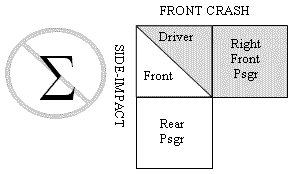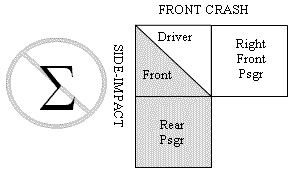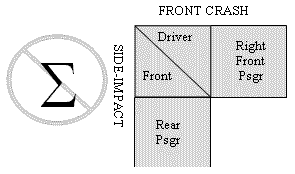|
GUIDELINES FOR USING NEW CAR ASSESSMENT PROGRAM (NCAP)
STAR RATINGS IN ADVERTISING AND COMMUNICATIONS
To promote accurate characterization and comparison of National Highway Traffic Safety Administration crash test results, the agency is releasing the following guidelines for manufacturers and advertising agencies. The following guidelines are effective immediately and apply to advertisements in print, the Web, TV or radio, press releases, and other various consumer-facing marketing communications.

- Frontal crash NCAP stars are to be listed separately from side-impact NCAP stars. Star ratings from the two tests cannot be added together (e.g. it is not permissible to add a 5-star frontal rating (driver seating position) with a 5-star side rating (front seating position) for an “overall” 10-star driver seating position crash rating).

- Frontal crash NCAP stars for the driver seating position are to be listed separately from frontal crash NCAP stars for the (right front) passenger seating position. Star ratings from the two front seating positions cannot be added together (e.g. it is not permissible to add a 5-star rating for the driver seating position with a (right front) passenger 5-star rating for an “overall” 10-star frontal crash rating). Additionally, if the star rating for the driver seating position is to be shown, results for the right front passenger must also be shown, and vice versa. Exception: for vehicles receiving 5-stars in front crash for both driver and right front passenger positions, manufacturers may consolidate the two separate 5-star ratings into one 5-star rating and use a phrase similar to that in guideline #5 below for the purposes of the advertisement.

- Side-impact NCAP stars for the front seating position are to be listed separately from the side-impact NCAP stars for the rear seating position. Side-impact star ratings from the front and rear seating positions cannot be added together (e.g. it is not permissible to add a 5-star rating for the front seating position with a rear passenger 5-star rating for an “overall” 10-star side-impact crash rating). Additionally, if the side-impact star rating for the front seating position is to be shown, results for the rear seating position must also be shown, and vice versa. Exception: for vehicles receiving 5-stars in side-impact for both front and rear seating positions, manufacturers may consolidate the two separate 5-star ratings into one 5-star rating and use a phrase similar to that in guideline #6 below for the purposes of the advertisement.

- In general, side-impact star ratings cannot be combined with frontal crash star ratings to develop an “overall” vehicle score (e.g. it is not permissible to add the 5-star ratings for both frontal and side-impact tests across any combination of seating positions to arrive at an “overall” vehicle rating based on 10, 15, or 20-stars). Exception: for vehicles receiving 5-stars in all seating positions for both frontal crash and side-impact, manufacturers may consolidate the four separate 5-star ratings into one 5-star rating and use a phrase similar to that in guideline #7 below for the purposes of the advertisement.
- Regarding frontal crash NCAP stars: a 5-star rating for both the driver and the right front passenger seating positions must be achieved before the vehicle can be characterized as “receiving the highest government frontal crash safety rating” or as having a “five star rating for frontal crash.” NHTSA strongly discourages the use of terms such as “double” 5-star rating when a vehicle has received a 5-star rating for both the driver and the right front passenger seating positions.
- Regarding side-impact NCAP stars: a 5-star rating for both the front and rear seating positions must be achieved before the vehicle can be characterized as “receiving the highest government side-impact safety rating” or as having a “five star rating for side-impact crash.” NHTSA strongly discourages the use of terms such as “double” 5-star rating when a vehicle has received a 5-star rating for both front and rear seating positions.
For those vehicles tested with side-impact air bags (SABs), a phrase similar to “model tested with optional/standard side-impact air bags (SABs)” must appear, at a minimum, in the disclaimer. Manufacturers may place the phrase in the body of the advertisement or as part of a voiceover.
- Regarding frontal crash and side-impact stars: a 5-star rating for all four crash seating positions (driver and right front passenger for frontal crash, and front and rear seating positions for side-impact) must be achieved before the vehicle can be characterized as “receiving the highest government crash test ratings” or as having “five star crash safety.” NHTSA strongly discourages the use of terms such as “quadruple” 5-star rating when a vehicle has received a 5-star rating across all four seating positions.
Use of the term “five-star safety” applies only to those vehicles receiving a 5-star rating for all four crash seating positions and rollover.
- Regarding misleading terminology: NHTSA discourages the use of language referring to “doubling,” “tripling” or “quadrupling” of a star rating as doing so implies the vehicle scored a star rating two, three or four times that of another 5-star vehicle, and therefore can be misleading to consumers.
NHTSA also discourages the use of potentially misleading words such as “perfect” or “flawless” to describe the star rating received by the vehicle. More acceptable phrases to describe a vehicle receiving a 5-star rating would include phrases such as “highest” or “maximum” crash test rating or “top” safety scores.
NHTSA also discourages the use of phrases placed in certain contexts that imply NHTSA has a new overall star rating system. For example, “vehicle ABC has earned the government’s highest rating – 5-stars all around.” NHTSA does not have a 5-star all-around rating.
- Regarding seating terminology: NHTSA expects manufacturers to use terminology for seating positions that is consistent with NHTSA NCAP seating terminology. NHTSA considers the use of the term “occupant” as misleading, since it is unclear whether the term refers to the driver or passenger. Manufacturers must, therefore, use the terms in bold below and not occupant. Seating positions for frontal crash results are typically referred to as driver and (right front) passenger seating positions. Seating positions for side-impact crash results are typically referred to as front and rear (passenger) seating positions. The words in parentheses can be used to provide additional clarity to the consumer.
- Regarding competitive comparisons: Advertisements that competitively compare frontal crash NCAP safety ratings of two or more vehicles can only be done if the vehicles being compared are within 500 pounds of each other. Competitive comparisons are not to be implied between vehicles where the difference in weight exceeds 500 pounds.
Vehicle comparison of frontal crash results can be done across weight categories (e.g. comparing a heavy passenger car to a medium passenger car) as long as the 500-pound comparison limit is not exceeded.
- Regarding the use of footnoted safety concerns: footnotes used by the agency to denote safety concerns experienced during NCAP crash tests must be clearly stated and be prominently displayed directly beneath, or after, the star rating in the body of the advertisement. Footnoted safety concerns are not to be included as part of the disclaimer. If NHTSA does not note the safety concern on its NCAP web site, then manufacturers do not have to place the safety concern in the main body of the advertisement.
Manufacturers who make a mid-model year running change to a vehicle to correct a footnoted safety concern and successfully pass an optional NCAP retest must include, in the disclaimer, that the revised star rating applies only to vehicles manufactured on or after the date of the running change.
- Regarding the use of voiceovers during TV commercials: The use of voiceovers during TV commercials must be consistent with the display of the NCAP star rating in use. For example, a commercial with a superimposed display of a 5-star frontal crash graphic midway through the spot and a voiceover at the end of the spot stating, “vehicle xyz…5 star safety” would be misleading.
- Regarding use of star ratings for corporate twins: Each year manufacturers provide NHTSA with a list of vehicles they have certified as “corporate twins.” If the vehicle manufacturer defines a vehicle as being a “corporate twin” of another vehicle, then the appropriate frontal, side-impact or rollover star ratings may apply to all those vehicles defined as corporate twins of one another. When a vehicle’s NCAP star ratings/test scores are released and if it has any corporate twins, that vehicle’s star ratings/test scores and all of its twins will be updated simultaneously on the safercar.gov website with the appropriate NCAP star ratings/test scores.
- Regarding use of the disclaimer: each advertisement utilizing the NCAP star ratings should have the following phrase(s) in the disclaimer, as applicable:
“Government star ratings are part of the National Highway Traffic Safety Administration’s (NHTSA’s) New Car Assessment Program (NCAP).”
For advertisements on the web, the disclaimer may appear as a pop-up during a mouse over.
- Regarding use of the NHTSA logo: the NHTSA logo may be used in an advertisement (print, web or TV) along with NCAP star ratings (per guidelines #1-14 above), provided the logo is displayed in immediate proximity to the star rating so as to indicate NHTSA’s association with the advertisement is limited to the star rating and not to the contents of the entire advertisement. Any advertisement using the NHTSA logo must be submitted in advance for approval per guideline #17 below. Advertisements that do not use the NHTSA logo do not need to be submitted for approval.
Vector based images of NHTSA’s logo are available for download by visiting ftp://ftp.nhtsa.dot.gov/AdSlicks/. Click on the Logos folder. Look for the Adobe Illustrator eps file named NHTSA.eps. The logo is shown below and the preferred logo color is Pantone 287.

- Regarding timing of test results: NHTSA may, under certain circumstances, permit the use of a manufacturer’s individual vehicle’s star rating for advertising purposes as long as that vehicle’s test report has successfully completed NHTSA’s quality control process. For questions regarding the status of a vehicle’s test report, please contact Nat Beuse in NHTSA’s Office of Crashworthiness Standards. Phone: 202-366-0938. Email: nbeuse@nhtsa.dot.gov.
- Regarding submission of materials: NHTSA is requesting that only advertising materials using the NHTSA logo with the star ratings be submitted for a swift review by NHTSA’s Office of Communications and Consumer Information. NHTSA anticipates a turnaround time of 1-2 business days. Each individual, unique advertisement or spot that will incorporate the NHTSA logo with the star ratings must be submitted for review. Manufacturers and their advertising firms may still voluntarily submit any advertisement if they wish to have NHTSA ensure they are acting in accordance with these guidelines. For questions regarding these guidelines or to submit materials for review, please contact Mark Krawczyk in NHTSA’s Office of Communications and Consumer Information. Phone: 202-366-6330. Email: mkrawczyk@nhtsa.dot.gov.
Preferred file formats are as follows:
For print advertisements: screen resolution pdf’s.
For radio spots: script in MS Word or text file format.
For television spots: VHS, CD-ROM or electronic file (Media Player or QuickTime compatible).
For Web advertisements: html or flash type file or link to an externally accessible website.
|